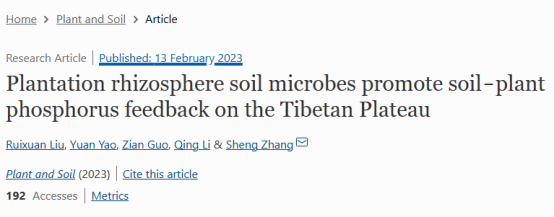Plantation rhizosphere soil microbes promote soil‒plant phosphorus feedback on the Tibetan Plateau
学员文章系列之33
Mixed effects model, structural equation model, multivariate analysis

Plantation rhizosphere soil microbes promote soil‒plant phosphorus feedback on the Tibetan Plateau
Plant and Soil, 13 February 2023
https://link.springer.com/article/10.1007/s11104-023-05939-2
https://mp.weixin.qq.com/s/RhvMWmqVrDdnrnzJuqCDhw
Abstract
Background and aims
Afforestation can alter belowground microbial diversity and affect soil‒plant feedback, which is crucial for understanding nutrient cycles and ecosystem productivity. Most studies have focused on the carbon and nitrogen cycles in forest ecosystems; however, there are few studies on the effect of afforestation in soil microbial diversity on phosphorus (P) nutrients. In this study, we explored the effect of soil microbial communities on soil‒plant P feedback under long-term afforestation.
Methods
Typical poplar plantations were selected from the Lhasa River Basin. We assessed the P content, activity of extracellular enzyme related to P acquisition, rhizosphere soil microbes, and mechanism of microbial community.
Results
Increased bacterial richness and evenness were beneficial to soil and plant P nutrition; however, the community differentiation of bacteria and fungi had no positive effect on the P content. Ecological stochasticity drove for the assembly of the rhizosphere soil microbial community after afforestation on the Tibetan Plateau. Homogenizing dispersal dominated bacterial and fungal assemblies. Ecological drift was another stochastic process that affected the microbial assembly.
Conclusion
Bacterial richness and evenness had positive effects on soil‒plant P feedback, whereas microbial differentiation did not. Homogenizing dispersal and ecological drift are intrinsic factors that regulate the effects of microbial community diversity on soil‒plant P feedback processes.
This study provides the evidence on the intrinsic mechanism of belowground microbial diversity influencing soil‒plant P feedback. It also provides new insights into the selection of plantation species on the Tibetan Plateau from the perspective of enhancement of P nutrition by microbes.


